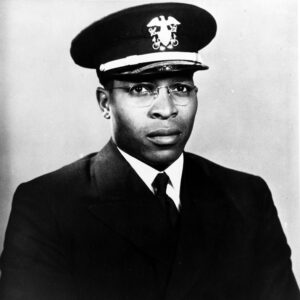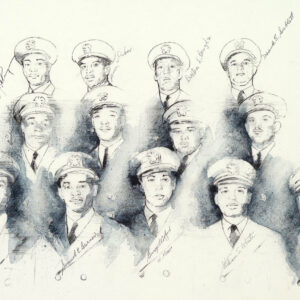calsfoundation@cals.org
Jesse Walter Arbor (1914–2000)
Serving in the U.S. Navy during World War II, Arkansas native Jesse Walter Arbor became one of the first thirteen African Americans commissioned as naval officers, known as the Golden Thirteen. Arbor served as a supply officer in various locations during the war.
Born in Cotton Plant (Woodruff County) on December 26, 1914, Jesse Arbor was the fifth of twelve children of Alexander and Lenora Arbor. His father worked as a carpenter and appeared in the federal census as a farmer, taking on multiple jobs to provide for the family. Arbor attended Cotton Plant Academy while living in Arkansas, but the family moved to Chicago around 1929, and the children attended Catholic school.
Arbor returned to Arkansas upon graduation from high school, attending Arkansas AM&N (now the University of Arkansas at Pine Bluff), where he played football. After taking classes for three and a half years, Arbor returned to Chicago after his football eligibility was gone. From 1935 to 1939, Arbor worked as a doorman at the Chicago Beach Hotel, a luxury resort located on Lake Michigan. Through the father of a friend from high school, Arbor obtained a job as a Pullman porter, which he performed for two years before returning to the hotel. Taking a job with the Kuppenheimer Company, a men’s clothing manufacturer, Arbor trained as a tailor. He opened his own shop in 1940 with ten employees.
Arbor did not want to join the military during World War II, but he learned in September 1942 that he would be drafted for the army. With three brothers serving in the army, Arbor knew that he did not want that branch of the service and enlisted in the Navy Reserve on September 11, 1942. Completing boot camp at Camp Robert Smalls, located at the Great Lakes Naval Training Center, Arbor underwent specialized training to serve as a quartermaster. Upon graduation, he received the rank of Quartermaster Third Class. Transferred to Boston, he served on the docks, guiding ships into their berths. He then took a short-term assignment on a minesweeper. Completing a navigation course at Harvard University, Arbor received a promotion to Quartermaster Second Class and an assignment to another minesweeper.
Arbor was selected to serve as a member of the first African American–crewed ship in the U.S. Navy, the USS Mason, but his assignment was rescinded before he could board the ship, and he had to return to Chicago, where he was selected to undergo officer training. Unaware of how or why he was selected, Arbor trained alongside fifteen other Black enlisted men. Upon the completion of their training, twelve of the men received commissions as ensigns, while one became a warrant officer, and three did not receive promotions. Arbor and his classmates received their commissions in the Navy Reserve on March 1, 1944.
Serving at the Great Lakes Naval Training Center for several months, he received a transfer to Oahu, Hawaii, in June 1944. In Hawaii, Arbor served as a company commander and filled a variety of roles, including commanding a Shore Patrol (or military police) detachment. In February 1945, Arbor transferred to Guam. Arbor served as Division Officer/Battalion Commander at the U.S. Naval Barracks No. 1 on Guam through the end of the war. He received a promotion to the rank of lieutenant, junior grade on August 1, 1945. Returning to the Great Lakes Naval Training Center in December 1945, Arbor received his release from active duty on April 1, 1946. During his service, Arbor earned three decorations: American Campaign Medal, Asiatic-Pacific Campaign Medal, and the World War II Victory Medal.
Arbor married Autry Brown in 1948, and the couple had three children.
Remaining in the Navy Reserve until 1954, Arbor operated a tailor shop in Chicago until 1969. He then operated a boiler in an elementary school until 1984. Arbor died on January 11, 2000, in Chicago and is buried at Evergreen Cemetery.
Thousands of African Americans subsequently served as officers in the navy following the Golden Thirteen.
For additional information:
Flink, John. “Jesse Arbor of ‘Golden Thirteen.’” Chicago Tribune, January 14, 2000. https://www.chicagotribune.com/news/ct-xpm-2000-01-14-0001140174-story.html (accessed October 26, 2023).
“Jesse Walter Arbor.” Naval History and Heritage Command. https://www.history.navy.mil/research/library/research-guides/modern-biographical-files-ndl/modern-bios-a/arbor-jesse-walter.html (accessed October 26, 2023).
Stillwell, Paul L. The Golden Thirteen: Recollections of the First Black Naval Officers. Annapolis, MD: Bluejacket Books/Naval Institute Press, 2013.
David Sesser
Southeastern Louisiana University
 Military
Military World War II through the Faubus Era, 1941 through 1967
World War II through the Faubus Era, 1941 through 1967 Jesse W. Arbor
Jesse W. Arbor  The Golden Thirteen
The Golden Thirteen 




Comments
No comments on this entry yet.